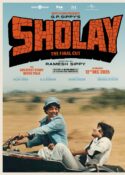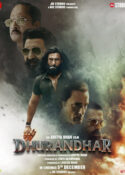 URF (“AKA”) Director Geetika Narang Abbasi, 2022
URF (“AKA”) Director Geetika Narang Abbasi, 2022
I spent a number of years living in France, and one of the most interesting words I learned was “sosie” – someone who perfectly resembles someone else, to the point that people could confuse them. I was familiar with impersonators, mostly comedians who did voice imitations of famous people, whether actors or singers. I knew about Elvis impersonators, people who would perform dressed as Elvis. But that’s as far as it went, until I discovered the world of “sosies” in France. Where impersonators or doubles were fairly marginalized here at home, in France I discovered a whole side business of people who resembled famous performers – usually singers – and would hire themselves out to perform at local events. Writer Yann Moix published a book called “Podium” about a bank employee who must choose between his family and the career he longs for: to be a “sosie” of the late, great French singer Claude François. Moix went on to turn his novel into a film starring Benoît Poelvoorde as the hapless bank employee dreaming of a kind of a profession that is, in a way, stardom adjacent.
So I was primed to be fascinated by the documentary URF (“Also Known As”) screening at this year’s London Indian Film Festival. URF explores the world of what are known as “duplicates” in India, performers who make a living by impersonating the more famous stars that they look like (and who are usually known as “Junior/Jr” versions of the stars they resemble. To this end, director/editor/producer Geetika Narang Abbasi follows three duplicates in particular: Kishore Bhanushali (Jr. Dev Anand), Firoz Khan (Jr Amitabh Bachchan) and Prashant Walde (Jr. Shah Rukh Khan).
I had actually been familiar with Bhanushali and Walde, though I didn’t know much about them apart from seeing them occasionally on screen – Bhanushali, in particular, had a bit of a heyday where he was in a lot of the films from the 1990s that I was watching in one period. So Abbasi’s film was an excellent way to get to know more about both them, and about Firoz Khan.
Khan, Bhanushali, and Walde are all careful to differentiate what they do from mimicry – already a comedic form very popular in India, and many mimicry artists – Johny Lever is probably one of the best examples – go on to have film careers, though they mostly are put in comedic roles and don’t have much opportunity to expand their careers beyond that (one of the exceptions I can think of is the Malayalam actor Jayaram who began his career as a mimicry artist but today boasts a varied and wide-ranging filmography). Bhanushali had never heard of Dev Anand when, at the age of eight, someone told him he looked like the Evergreen actor. He sought out the Anand film Jewel Thief. With the realization that he did, in fact, resemble Dev Anand, Bhanushali began dressing like the actor and copying his trademark gestures.
All three men are fans of the actors they are duplicates of and yet all three dream of differentiating themselves from their more famous faces. Bhanushali left the movies behind in order to sing, though sadly, the people who hire him for events still seem to take more joy in clicking photos with Jr. Dev Anand than listening to Kishore Bhanushali sing. Prashant Walde has been a body double for his lookalike SRK, but he is uncomfortable with the idea that his own son might become a “junior”. For Firoz Khan, who actually does not resemble Amitabh Bachchan until he is made over with make up, facial hair and a wig, the secret to being Jr Amit is in studying the mannerisms and gestures of his favourite actor. For him, being Jr Amit did not mean mimicking his hero, it meant learning how to act as him. For Khan, that’s meant learning how to expand what he does as an actor, and moving into working in serials. He’s helped by his daughter who shares the dream of seeing her father just being an actor beyond being a duplicate.
Abbasi’s documentary approaches her subjects with respect, exploring their motivations for working as duplicates, and giving us insight into this fame-adjacent world. This is a world of mimicry stages and duplicate films (like Duplicate Sholay and the Amir Salmaan Anthony shown in the film). There are times when people mistake these men for the stars they resemble; but just as often, they know they aren’t those stars, but are just as happy to take pictures with them, perhaps because that’s as close as they will ever get to an actor they love. But there are also frustrations.
For Walde, his resemblance to SRK seems like a mixed blessing: it gets him work as the actor’s body double, but he notes that he’s often used in rehearsals before the actor shows up for work, and is never seen on screen. By the very nature of being a perfect duplicate, his own self ends up sublimated, in a way. He is never Prashant Walde, but is always in the shadow of SRK. Walde is adamant that his son not become a duplicate, preferring that he forge his own identity, something Walde clearly wants to do himself.
Khan echoes this thought when he says, “No matter how good you are, or how natural your depiction is, a mimic will always remain a mimic. The audience doesn’t get to know if you can do anything beyond mimicry.” Khan’s pleasure at finally being offered acting roles that don’t involve mimicry is palpable. Khan notes how very important it is for actors to achieve recognition, and they cannot do that if they live in the shadow of another actor. “Being known by one’s own name, howsoever big or small, is essential.”
Walde and Bhanushali, too, struggle with the issue of identity and recognition. Despite their obvious desire to be seen as themselves, all of these men express a kind of gratitude for being offered the opportunities they’ve had. They might be duplicates, but Abbasi reveals how much more these three men are than just mere shadows. Each is talented in his own way; each has tried in the course of his career to find ways to allow talents to shine.
In the end, each of them proves that to be a duplicate is also to be a fan, and to bring happiness to others in the way they express their fan status. Walde notes that people’s first reaction to what he does is often to laugh, but he doesn’t let it bother him. “Instead,” he says, “I like to think that I managed to bring a smile to someone’s face. Perhaps that person has laughed after a long time. It feels good.”
And ultimately, what Abbasi gives us is the pleasure of getting to know these three men, to learn a little about their motivations, their joys, their sadness. URF is such a thoughtful examination of the duplicate phenomenon through the eyes of three of its practitioners, and, to echo Walde’s thoughts, it feels good just to watch.
URF had it’s UK premiere and was showcased at the London Indian Film Festival 2022. The festival continues in London, Birmingham and Manchester and you can find out more on https://londonindianfilmfestival.co.uk/. Plus see what you can watch online at https://www.loveliffathome.com/









